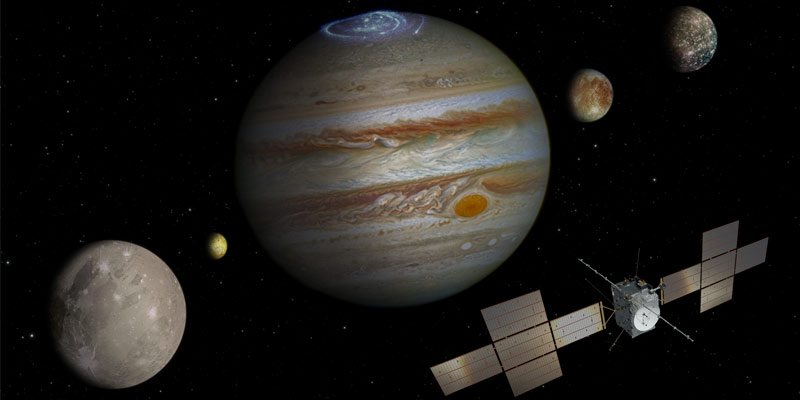- World
- Jan 24
ESA to launch Jupiter explorer mission in April
• The European Space Agency’s (ESA) Jupiter Icy Moons Explorer (JUICE) has been confirmed for launch from the agency’s spaceport in French Guiana in April 2023.
• JUICE is set to embark on an eight-year cruise to Jupiter starting in April 2023.
• The mission will investigate the emergence of habitable worlds around gas giants and the Jupiter system as an archetype for the numerous giant planets now known to orbit other stars.
Significance of this mission
• As part of the final preparations a commemorative plaque was mounted on the spacecraft as a tribute to Italian astronomer Galileo Galilei who was the first to view Jupiter and its four largest moons through a telescope in January 1610.
• His observation that the moons changed position from night to night overturned the long-held idea that everything in the heavens revolved around Earth. The moons — Io, Europa, Ganymede and Callisto – were to become collectively known as the Galilean satellites in his honour.
• The spacecraft has just completed its final tests before departing Toulouse, France, for Europe’s spaceport.
• ESA and its international partners are sending JUICE on its quest to explore this fascinating planet and intriguing moons.
• With its suite of powerful instruments, JUICE will see Jupiter and its moons in a way that Galileo couldn’t even have dreamt of. The data returned by the spacecraft will serve many future generations of scientists determined to uncover the mysteries of the jovian system and its place in the evolution of our Solar System.
• Three of Jupiter’s largest moons — Europa, Ganymede and Callisto — hold vast quantities of water buried under their surfaces in volumes far greater than in Earth’s oceans.
• These planet-sized moons offer tantalising hints that conditions for life could exist other than here on our pale blue dot, orbiting giant planets instead of hot stars.
• Jupiter and its family of large moons represent an archetype for giant gas planet systems across the Universe and as such are some of the most compelling destinations in our Solar System.
Extreme navigation techniques
• On its journey JUICE will make a series of flybys of Earth, the Earth-Moon system and Venus to set it on course for its July 2031 rendezvous in the Jovian system.
• JUICE will make three Earth flybys during its cruise: one of the Earth-Moon system in August 2024, one of Earth in September 2026, and once again one of Earth in January 2029.
• In total JUICE will spend approximately eight years cruising to Jupiter. It will reach Jupiter in July 2031, but will already begin making scientific observations six months before entering orbit around Jupiter.
• JUICE will go on to spend many months orbiting Jupiter, making 35 flybys of icy moons Europa, Ganymede and Callisto, and finally conducting an orbital tour of Ganymede.
• Once it arrives in the Jupiter system, JUICE will face a harsh radiation and temperature environment, hundreds of millions of kilometres from Earth, in order to gather data that will uncover the mysteries of the planet’s complex environment and ocean-bearing moons.
• To fly such a complex path from such an enormous distance – and vitally, to get JUICE’s data home — will require extreme navigation techniques, reliant on ESA’s Estrack network of deep space antennas in Spain, Argentina and Australia, controlled remotely from ESA’s Space Operations Centre (ESOC) in Darmstadt, Germany.
• JUICE’s cameras will capture exquisite details of the moon’s features, as well as identify the ices and minerals on their surfaces. Other instruments will sound the subsurface and interior of the moons to better understand the location and nature of their buried oceans. The tenuous atmosphere around the moons will also be explored.
Manorama Yearbook app is now available on Google Play Store and iOS App Store

